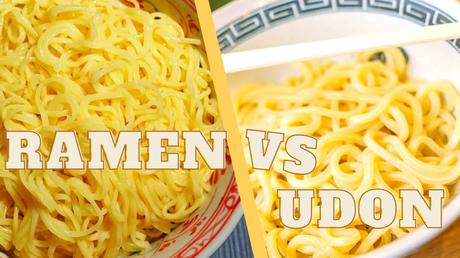Ramen and udon noodles are frequently found in Japanese cuisine. They are quick to prepare and go wonderfully with a range of dishes.
Both ramen and udon are made from wheat-flour, though udon noodles are thicker and therefore more filling.
Udon noodles are usually straight, whereas ramen is curly and can come in various shapes and lengths.

But there are more differences between them.
Read on for a more in-depth comparison of these two awesome noodle types, as well as recommendations for top brands and popular dishes.
Ramen vs. Udon Noodles: Taste
Ramen noodles have a salty, savory taste and are served in a meat-based broth, though vegetable and fish-based broths are also available.
The type of broth can have an impact on taste, as it is often also flavored with condiments such as soy sauce.
Udon has a more subtle taste and is commonly seasoned in a mild-flavored broth called kakejiru that is made of soy sauce, mirin and dashi stock.
Udon noodles absorb the flavor of the broth they are made in more easily than ramen.
Ramen vs. Udon Noodles: Uses
Udon has a springy, doughy quality that makes it a versatile noodle to cook with.
It is often served hot as a noodle soup, but its soft and chewy texture also makes it great in stir-fry.
Typical toppings that udon noodles are matched with include scallions, tempura, and aburaage (deep-fried tofu).
You can also serve it cold in udon salad, alongside fresh vegetables, eggs, and shredded chicken. Pair it with prawn or shrimp and you get a variety of seafood udon dishes.
Ramen is also excellent as a soup or stir-fry. Mix it with eggs and you can make a ramen omelet or frittata.
You can even serve it chilled with fresh produce in a ramen salad, or add cheese to make a ramen mac n’ cheese alternative.
Other toppings that go well with this versatile noodle include but are not limited to sliced pork, scallions, and nori (seaweed).
Read more about ramen here: Different types of Japanese Ramen explained like Shoyu & Shio.
Ramen vs. Udon Noodles: Cooking Time
Dried ramen noodles are super easy to make.
It goes as follows:
- First, boil 2½ cups of water in a saucepan.
- Then, add the noodles and let them cook for 2 minutes.
- Once the noodles start to soften, add the flavor packet, and stir thoroughly.
- Do not pour away any cooking liquid as you will also lose flavor.
Alternatively, you can toss the noodles in a pan at this stage and fry them with oil or your favorite sauce.
This same process can be used for udon noodles. The length of cooking time can depend on whether you’re making semi-dried or dried udon.
For the latter, cooking time can be up to 10-12 minutes. If you are serving your noodles hot, scoop them into a strainer and drain them gently over the pot.
Ramen vs. Udon Noodles: Common Dishes
Both ramen and udon noodles are popular ingredients in varied Asian dishes.
Common Dishes with Udon
Udon noodles as a hot soup are referred to as kake udon, and uses the kakejiru broth.
Stir-fry the noodles with soy sauce and you’ll have made yaki udon.
Other common dishes include tempura udon, which is garnished with prawn tempura or tempura fritters, and stamina udon, a type of udon that is mixed with meat, egg, and vegetables.
Curry udon, as the name suggests, uses curry powder to season the broth. Zaru udon is a chilled dish served with a dipping sauce and presented on a bamboo mat.
Common Dishes with Ramen
Ramen dishes are often categorized based on broth flavor. Shoyu ramen is one classic, flavored with soy sauce and garnished with nori, bean sprouts, menma and boiled eggs.
Shio ramen has a primarily salty flavor and is made with a mix of sliced meat, vegetables and seaweed. Miso ramen uses miso paste and has a nutty and slightly sweet taste.
Other common dishes include curry ramen, a curry-seasoned alternative, tonkotsu ramen, which uses a pork bone-based broth, and hiyashi chuka, a chilled ramen served in summer.
Lastly, champon, a regional dish of Nagasaki combines ramen with pork, seafood, and vegetables that are fried with lard. Different versions of champon exist in China and Korea.
Ramen vs Udon Noodles: Best Brands
Best Brands Ramen
There are many choices when it comes to picking a ramen noodle brand.
Here are some of our top picks:
- Samyang Ramen’s spicy chicken roasted noodles come with spaghetti-style noodles and a fantastic hot sauce.
- Nongshim Shin Spicy Ramen is made with a savory beef broth and comes in a gourmet cup that is perfect for when you’re on the go.
- Nissin Cup Ramen is an authentic and creamy noodle soup, served with calamari, imitation crab, scrambled eggs, and cabbage.
- Lotus Foods Millet & Brown Rice Ramen is seasoned with miso and a great gluten-free alternative.
- Nissin Top Ramen comes in a soy sauce flavor and is suitable for vegetarians.
Best Brands Udon
And now for our udon noodle recommendations:
- Neoguri Udon Noodles has a delicious spicy seafood flavor that uses a unique blend of spices.
- Hime Dried Udon Noodles is made with premium wheat and works wonderfully with a range of recipes.
- Maruchan Instant Lunch Udon is a family favorite that’s packed with flavor, seasoned with soy sauce in an earthy, salty broth.
- Annie Chun’s Organic Udon Noodles is suitable for vegans and perfect for stir-frys.
- Nongshim Udon Premium Noodle Soup comes with fresh noodles and delicious flavor but is slightly more expensive.
So, which one is your favorite, ramen or udon noodles?
Wondering how ramen compares to pho? Read Ramen vs. Pho | Both Noodles with Broth, But a World of Difference.
